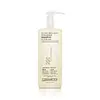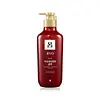What's inside
What's inside
 Key Ingredients
Key Ingredients

 Benefits
Benefits

 Concerns
Concerns

 Ingredients Side-by-side
Ingredients Side-by-side

Water
Skin ConditioningSodium Coco-Sulfate
CleansingCocamidopropyl Betaine
CleansingSodium Cocoamphoacetate
CleansingMelaleuca Alternifolia Leaf Oil
AntioxidantMentha Piperita Oil
MaskingRosmarinus Officinalis Leaf Extract
AntimicrobialMenthol
MaskingGlycerin
HumectantEucalyptus Globulus Leaf Oil
PerfumingLauryl Glucoside
CleansingLavandula Angustifolia Flower/Leaf/Stem Extract
MaskingSodium Cocoyl Glutamate
CleansingAloe Barbadensis Leaf Juice
Skin ConditioningSodium Lauryl Glucose Carboxylate
CleansingDecyl Glucoside
CleansingPolyquaternium-7
Polysorbate 20
EmulsifyingParfum
MaskingSalvia Officinalis Leaf Extract
CleansingPanthenol
Skin ConditioningCitric Acid
BufferingPhenoxyethanol
PreservativeEthylhexylglycerin
Skin ConditioningPotassium Sorbate
PreservativeChamomilla Recutita Flower Extract
MaskingThymus Vulgaris Extract
PerfumingWater, Sodium Coco-Sulfate, Cocamidopropyl Betaine, Sodium Cocoamphoacetate, Melaleuca Alternifolia Leaf Oil, Mentha Piperita Oil, Rosmarinus Officinalis Leaf Extract, Menthol, Glycerin, Eucalyptus Globulus Leaf Oil, Lauryl Glucoside, Lavandula Angustifolia Flower/Leaf/Stem Extract, Sodium Cocoyl Glutamate, Aloe Barbadensis Leaf Juice, Sodium Lauryl Glucose Carboxylate, Decyl Glucoside, Polyquaternium-7, Polysorbate 20, Parfum, Salvia Officinalis Leaf Extract, Panthenol, Citric Acid, Phenoxyethanol, Ethylhexylglycerin, Potassium Sorbate, Chamomilla Recutita Flower Extract, Thymus Vulgaris Extract
Water
Skin ConditioningSodium Laureth Sulfate
CleansingAmmonium Lauryl Sulfate
CleansingDimethicone
EmollientCocamide Methyl Mea
Parfum
MaskingSodium Lauroyl Sarcosinate
CleansingGuar Hydroxypropyltrimonium Chloride
Skin ConditioningPhenoxyethanol
PreservativeLauric Acid
CleansingCetyl Alcohol
EmollientCocamide Mea
EmulsifyingSodium Cocoamphoacetate
CleansingSodium Benzoate
MaskingCitric Acid
BufferingTrihydroxystearin
Skin ConditioningDi-C12-13 Alkyl Malate
EmollientCaprylyl Glycol
EmollientSodium Salicylate
PreservativeSodium Citrate
BufferingDisodium EDTA
Sodium Chloride
MaskingHexyl Cinnamal
PerfumingBenzyl Benzoate
AntimicrobialEthylhexylglycerin
Skin ConditioningLinalool
PerfumingLaureth-23
CleansingLaureth-3
EmulsifyingLimonene
PerfumingMalt Extract
Skin ProtectingCitronellol
PerfumingAlpha-Isomethyl Ionone
PerfumingCarbomer
Emulsion StabilisingButylene Glycol
HumectantTetrasodium EDTA
Camellia Japonica Seed Oil
EmollientPunica Granatum Fruit Extract
AntioxidantLactic Acid
BufferingTocopherol
AntioxidantAlcohol
AntimicrobialArgania Spinosa Kernel Oil
EmollientHelianthus Annuus Seed Oil
EmollientCamellia Sinensis Seed Oil
HumectantPPG-3 Caprylyl Ether
SolventAlcohol Denat.
AntimicrobialGlycolipids
Skin ConditioningGlycyrrhiza Glabra Root Extract
BleachingXylitylglucoside
HumectantAnhydroxylitol
HumectantAmodimethicone
Xylitol
HumectantCamellia Sinensis Leaf Extract
AntimicrobialCornus Officinalis Fruit Extract
Skin ConditioningPanax Ginseng Root Extract
EmollientZingiber Officinale Root Extract
MaskingDipropylene Glycol
HumectantNelumbo Nucifera Flower Extract
Skin ConditioningPaeonia Lactiflora Root Extract
Skin ConditioningRehmannia Glutinosa Root Extract
Skin ConditioningRoyal Jelly Extract
Skin ConditioningGlucose
HumectantHoney
HumectantLilium Candidum Bulb Extract
Skin Conditioning1,2-Hexanediol
Skin ConditioningAcetic Acid
BufferingSchisandra Chinensis Fruit Extract
Skin ConditioningTrideceth-10
CleansingPolygonatum Odoratum Rhizome Extract
Skin ConditioningWater, Sodium Laureth Sulfate, Ammonium Lauryl Sulfate, Dimethicone, Cocamide Methyl Mea, Parfum, Sodium Lauroyl Sarcosinate, Guar Hydroxypropyltrimonium Chloride, Phenoxyethanol, Lauric Acid, Cetyl Alcohol, Cocamide Mea, Sodium Cocoamphoacetate, Sodium Benzoate, Citric Acid, Trihydroxystearin, Di-C12-13 Alkyl Malate, Caprylyl Glycol, Sodium Salicylate, Sodium Citrate, Disodium EDTA, Sodium Chloride, Hexyl Cinnamal, Benzyl Benzoate, Ethylhexylglycerin, Linalool, Laureth-23, Laureth-3, Limonene, Malt Extract, Citronellol, Alpha-Isomethyl Ionone, Carbomer, Butylene Glycol, Tetrasodium EDTA, Camellia Japonica Seed Oil, Punica Granatum Fruit Extract, Lactic Acid, Tocopherol, Alcohol, Argania Spinosa Kernel Oil, Helianthus Annuus Seed Oil, Camellia Sinensis Seed Oil, PPG-3 Caprylyl Ether, Alcohol Denat., Glycolipids, Glycyrrhiza Glabra Root Extract, Xylitylglucoside, Anhydroxylitol, Amodimethicone, Xylitol, Camellia Sinensis Leaf Extract, Cornus Officinalis Fruit Extract, Panax Ginseng Root Extract, Zingiber Officinale Root Extract, Dipropylene Glycol, Nelumbo Nucifera Flower Extract, Paeonia Lactiflora Root Extract, Rehmannia Glutinosa Root Extract, Royal Jelly Extract, Glucose, Honey, Lilium Candidum Bulb Extract, 1,2-Hexanediol, Acetic Acid, Schisandra Chinensis Fruit Extract, Trideceth-10, Polygonatum Odoratum Rhizome Extract
 Reviews
Reviews

Ingredients Explained
These ingredients are found in both products.
Ingredients higher up in an ingredient list are typically present in a larger amount.
Citric Acid is an alpha hydroxy acid (AHA) naturally found in citrus fruits like oranges, lemons, and limes.
Like other AHAs, citric acid can exfoliate skin by breaking down the bonds that hold dead skin cells together. This helps reveal smoother and brighter skin underneath.
However, this exfoliating effect only happens at high concentrations (20%) which can be hard to find in cosmetic products.
Due to this, citric acid is usually included in small amounts as a pH adjuster. This helps keep products slightly more acidic and compatible with skin's natural pH.
In skincare formulas, citric acid can:
While it can provide some skin benefits, research shows lactic acid and glycolic acid are generally more effective and less irritating exfoliants.
Most citric acid used in skincare today is made by fermenting sugars (usually from molasses). This synthetic version is identical to the natural citrus form but easier to stabilize and use in formulations.
Read more about some other popular AHA's here:
Learn more about Citric AcidEthylhexylglycerin (we can't pronounce this either) is commonly used as a preservative and skin softener. It is derived from glyceryl.
You might see Ethylhexylglycerin often paired with other preservatives such as phenoxyethanol. Ethylhexylglycerin has been found to increase the effectiveness of these other preservatives.
Parfum is a catch-all term for an ingredient or more that is used to give a scent to products.
Also called "fragrance", this ingredient can be a blend of hundreds of chemicals or plant oils. This means every product with "fragrance" or "parfum" in the ingredients list is a different mixture.
For instance, Habanolide is a proprietary trade name for a specific aroma chemical. When used as a fragrance ingredient in cosmetics, most aroma chemicals fall under the broad labeling category of “FRAGRANCE” or “PARFUM” according to EU and US regulations.
The term 'parfum' or 'fragrance' is not regulated in many countries. In many cases, it is up to the brand to define this term.
For instance, many brands choose to label themselves as "fragrance-free" because they are not using synthetic fragrances. However, their products may still contain ingredients such as essential oils that are considered a fragrance by INCI standards.
One example is Calendula flower extract. Calendula is an essential oil that still imparts a scent or 'fragrance'.
Depending on the blend, the ingredients in the mixture can cause allergies and sensitivities on the skin. Some ingredients that are known EU allergens include linalool and citronellol.
Parfum can also be used to mask or cover an unpleasant scent.
The bottom line is: not all fragrances/parfum/ingredients are created equally. If you are worried about fragrances, we recommend taking a closer look at an ingredient. And of course, we always recommend speaking with a professional.
Learn more about ParfumPhenoxyethanol is a preservative that has germicide, antimicrobial, and aromatic properties. Studies show that phenoxyethanol can prevent microbial growth. By itself, it has a scent that is similar to that of a rose.
It's often used in formulations along with Caprylyl Glycol to preserve the shelf life of products.
We don't have a description for Sodium Cocoamphoacetate yet.
Water. It's the most common cosmetic ingredient of all. You'll usually see it at the top of ingredient lists, meaning that it makes up the largest part of the product.
So why is it so popular? Water most often acts as a solvent - this means that it helps dissolve other ingredients into the formulation.
You'll also recognize water as that liquid we all need to stay alive. If you see this, drink a glass of water. Stay hydrated!
Learn more about Water